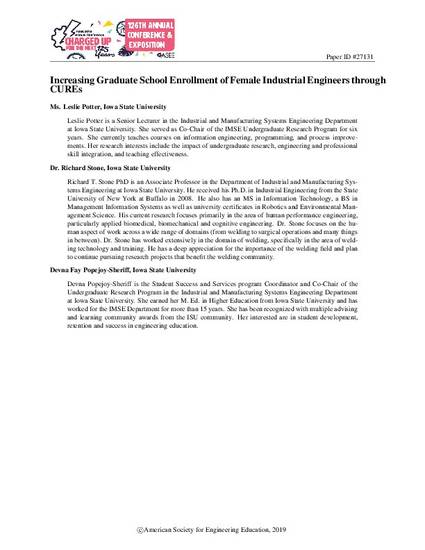
This is a Work in Progress paper. Decades after recognizing the need for more women engineers, increasing the number of women enrolling in engineering graduate schools still remains a challenge. From ASEE data published for 2017, record percentages of engineering degrees were awarded to women for Bachelors, Masters, and PhDs at 21.3%, 25.7%, and 23.5% respectively. Per the US Census Bureau, women comprise 50.8% of the American population; therefore, we must ask, “why aren’t 50% of engineering degrees awarded to women?” Within the industrial, manufacturing, and systems engineering professions, a higher percentage of women earn degrees (32.7% BS; 25.5% MS; 26.6% PhD) than for all engineering disciplines combined, but these numbers still don’t approach 50% of the population. To increase the percentage of female industrial engineers pursuing graduate school in the Industrial and Manufacturing Systems Engineering department at Iowa State University, we have implemented a Course-Based Undergraduate Research Experience (CURE) into a second-year human factors course. It is hypothesized that having this experience will encourage more women to continue their industrial engineering education beyond their bachelor’s degrees. A preliminary trial was run in the Spring 2018 semester, and a follow-up trial is being run in the Spring 2019 semester. Eighty-nine students (male and female) who experience the CURE pedagogy will be tracked longitudinally and compared to students who learn the same material through traditional lecture pedagogy. This paper describes the process, initial results from the Spring 2018 semester, and changes for the Spring 2019 semester, along with lessons learned about using a CURE pedagogy, measuring retention, and tracking graduate enrollments.
Available at: http://works.bepress.com/richard_stone/33/

This proceeding is published as Potter, Leslie, Richard T. Stone, and Devna F. Popejoy-Sheriff. "Increasing Graduate School Enrollment of Female Industrial Engineers through CUREs." Paper ID #27131. 2019 ASEE Annual Conference & Exposition, Tampa, FL. https://peer.asee.org/32960. Posted with permission.